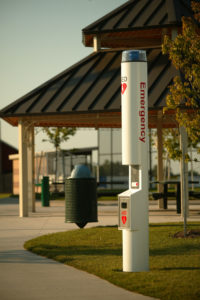For decades, blue light phones have stood as a visible sign to a commitment to security at colleges and universities around the world, providing a direct link to help and also serving as a deterrent to potential crime.
There’s no doubt that mobile safety apps have increased in popularity as cell phones become more prevalent as a tool to reach first responders, but that doesn’t eliminate the need for durable and scalable emergency communications solutions like blue light phones.
 During a recent webinar hosted by College Planning & Management magazine, a security director from a large east coast university said he remains a fan of blue light phones despite the ubiquitous influence of smartphones:
During a recent webinar hosted by College Planning & Management magazine, a security director from a large east coast university said he remains a fan of blue light phones despite the ubiquitous influence of smartphones:
“The reason why I think blue light phones should still be around is, first of all, it is a sense of comfort for individuals who walk around the campus and may not have their phone with them. They could be running or jogging and may not have their phone, or you have visitors that come to campus, parents who might be coming in with their high schoolers to look at campus for admission purposes, and are not going to know necessarily the emergency number in the event that something happens. But a blue light phone that is tied back to a university’s command center or police or security department would be one of the quickest ways to get some help.”
Blue light phones also can be enhanced with additional safety devices, like surveillance cameras, public address speakers, mass notification software, card readers, housings for automated external defibrillators (AED) and more, turning them into an integrated security station capable of serving the campus in multiple roles and augmenting mobile security apps. Other advantages blue light phones possess include pinpoint location during an emergency, universal accessibility and high reliance.
To learn how blue light phones serve to strengthen a multilayered security strategy, click here.
